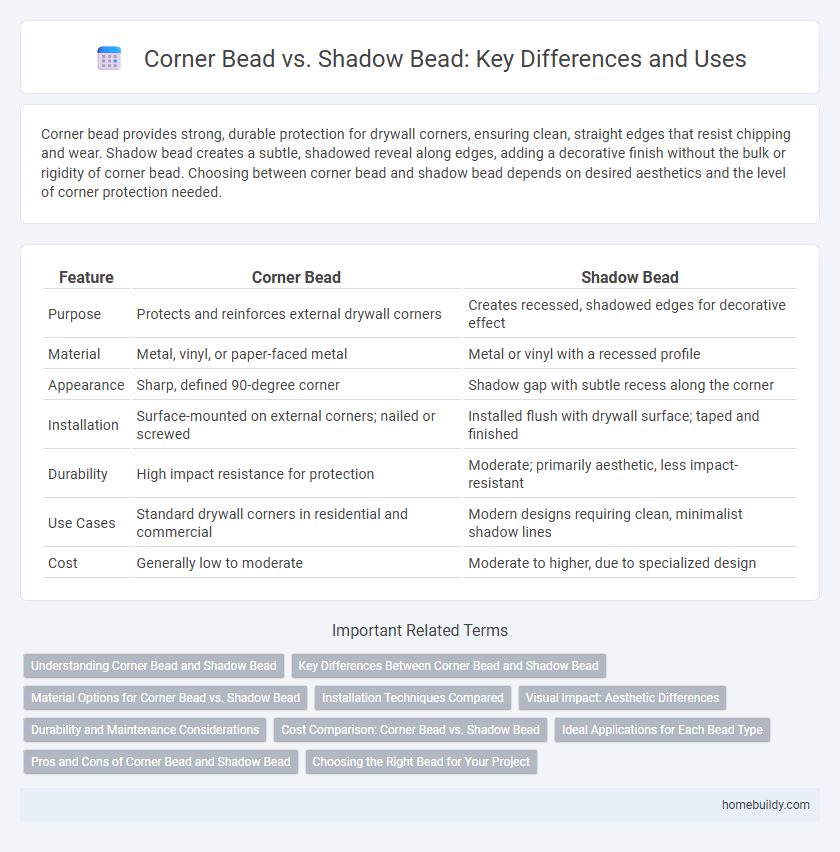Corner bead provides strong, durable protection for drywall corners, ensuring clean, straight edges that resist chipping and wear. Shadow bead creates a subtle, shadowed reveal along edges, adding a decorative finish without the bulk or rigidity of corner bead. Choosing between corner bead and shadow bead depends on desired aesthetics and the level of corner protection needed.
Table of Comparison
| Feature | Corner Bead | Shadow Bead |
|---|---|---|
| Purpose | Protects and reinforces external drywall corners | Creates recessed, shadowed edges for decorative effect |
| Material | Metal, vinyl, or paper-faced metal | Metal or vinyl with a recessed profile |
| Appearance | Sharp, defined 90-degree corner | Shadow gap with subtle recess along the corner |
| Installation | Surface-mounted on external corners; nailed or screwed | Installed flush with drywall surface; taped and finished |
| Durability | High impact resistance for protection | Moderate; primarily aesthetic, less impact-resistant |
| Use Cases | Standard drywall corners in residential and commercial | Modern designs requiring clean, minimalist shadow lines |
| Cost | Generally low to moderate | Moderate to higher, due to specialized design |
Understanding Corner Bead and Shadow Bead
Corner bead provides durable protection and sharp, clean edges for drywall corners, typically made from metal or plastic. Shadow bead creates a recessed shadow line effect at inside corners, enhancing architectural detail and visual depth without bulk. Choosing between corner bead and shadow bead depends on whether the goal is structural reinforcement or decorative accentuation of drywall corners.
Key Differences Between Corner Bead and Shadow Bead
Corner bead provides a protective edge and sharp, clean lines on drywall corners, offering durability against impacts. Shadow bead creates a recessed line or shadow effect at the joint, enhancing aesthetic appeal without reinforcing the corner. The key difference lies in corner bead's functional reinforcement versus shadow bead's decorative purpose.
Material Options for Corner Bead vs. Shadow Bead
Corner bead is typically made from galvanized steel, aluminum, or PVC, offering strong durability and corrosion resistance for wall edges. Shadow bead, often manufactured from flexible vinyl or rubber, provides a softer finish suitable for curved or irregular surfaces. These material options influence the choice between corner bead and shadow bead based on the required rigidity and aesthetic finish.
Installation Techniques Compared
Corner bead installation requires securing metal or vinyl strips directly to drywall corners for protection and clean edges, typically using nails, screws, or adhesive. Shadow bead involves embedding a recessed bead along the corner, creating a shadow line that demands precise drywall taping and finishing techniques to maintain the subtle profile. Both methods need accurate alignment and finishing, but corner bead offers more straightforward attachment, whereas shadow bead requires meticulous drywall compound application for the desired aesthetic.
Visual Impact: Aesthetic Differences
Corner bead creates sharp, defined edges that enhance the structural clarity of walls and corners, providing a crisp, polished look. Shadow bead introduces a subtle gap or shadow along edges, adding depth and softness that can reduce the harshness of corners while maintaining a modern aesthetic. Choosing between corner bead and shadow bead significantly affects the visual impact, with corner bead emphasizing precision and shadow bead enhancing dimensionality and visual interest.
Durability and Maintenance Considerations
Corner bead, typically made of galvanized steel or PVC, offers superior durability due to its resistance to dents and corrosion, making it ideal for high-traffic areas. Shadow bead, while providing a cleaner aesthetic with its recessed edge, usually requires more frequent maintenance to prevent chipping and damage. The robust construction of corner bead reduces long-term repair costs, enhancing overall wall longevity compared to the more delicate shadow bead.
Cost Comparison: Corner Bead vs. Shadow Bead
Corner bead generally costs less than shadow bead due to its simpler design and widespread use in drywall finishing. Shadow beads, offering a more refined shadow reveal look, often come at a higher price point because of specialized materials and installation requirements. Choosing between corner bead and shadow bead depends largely on budget constraints and the desired aesthetic effects.
Ideal Applications for Each Bead Type
Corner bead is ideal for reinforcing and protecting external drywall corners, providing clean, crisp edges in high-traffic areas like commercial buildings and residential walls. Shadow bead is best suited for creating subtle recesses and decorative shadow lines, often used in interior design applications such as feature walls and ceilings. Choosing the correct bead type depends on the desired aesthetic and functional requirements of the drywall installation.
Pros and Cons of Corner Bead and Shadow Bead
Corner bead provides strong protection and a clean, sharp edge for drywall corners, making it ideal for high-traffic areas prone to damage. Shadow bead offers a sleek, recessed line that creates a modern aesthetic but is less durable against impacts. While corner bead is easier to install and reinforces corners effectively, shadow bead requires precise application and is more suited for decorative purposes rather than heavy-duty protection.
Choosing the Right Bead for Your Project
Corner bead provides durable reinforcement and clean, precise edges for drywall corners, making it ideal for high-traffic areas prone to impact. Shadow bead offers a recessed, shadowed profile that enhances architectural detail and is best suited for decorative applications emphasizing subtle depth. Selecting the right bead depends on balancing durability needs with the desired aesthetic effect for your drywall project.
corner bead vs shadow bead Infographic

 homebuildy.com
homebuildy.com